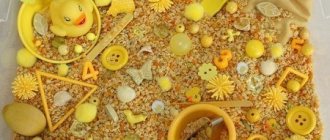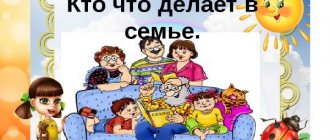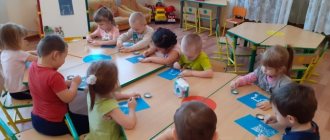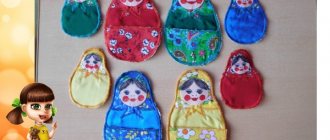Lesson summary “My rights and responsibilities” – Info-kids
- Program content:
- — Summarize children's knowledge about their civil rights and responsibilities;
- — Contribute to the development of legal worldview and moral ideas;
- — Develop the ability to reason, compare, draw conclusions;
- — Foster a sense of self-esteem and respect for other people.
- Equipment and materials:
- — Demonstration: pictures with the letter “I”, family trees, illustrations about children’s rights, birth certificates, posters with children’s drawings, “Universal Declaration of Human Rights”, “Children’s Rights” by E. Shabelnik;
- — Handout: album sheet, felt-tip pen, illustrations for fairy tales.
- Progress of the lesson:
- The teacher reads A. Barto’s poem “Loneliness”:
- No, I'm leaving for good!
- Then I'll bore my dad:
- I'm pestering you with questions,
- Then I won’t finish my porridge,
- So don't argue with adults!
- I will live alone in the forest,
- I'll save some strawberries.
- It's good to live in a hut
- And I don’t want to go home.
- Like dad, I like it
- Loneliness.
- I will find an abandoned pond,
- Hidden in the thicket,
- I'll start conversations
- With frogs.
- I will listen to the bird whistle
- In the morning, in the woods.
- Only I’m a football player,
- And there is no one to play with.
- It's good to live in a hut,
- Only bad at heart!
- Educator:
- - Why do you think the boy suddenly began to like loneliness?
- -What could have happened that he decided to live alone in the forest?
- -Do you ever have such a desire and mood?
-Why does it appear to you? What is the reason for this?
- - Is it good to be alone?
- — What should you do to make your mood cheerful and joyful?
- Exercise “Kind words”
- Guys, do you know what rights children have?
- Child:
- — Moms, dads of the whole country
- We should have known this a long time ago
- Their children have rights
- For example, reading books.
- Also for care, affection
- And to life, as if in a fairy tale,
- Still the right to be happy
- In our best world!
- Showing children the book “The Universal Declaration of Human Rights.”
- All people have rights. They are written about in this book. Do you think children have rights? What do you think they are?
— This is an unusual book. She will tell you about human rights and about your rights - the rights of a child. They are written in the Declaration of the Rights of the Child, which was created and adopted by the United Nations.
This organization exists all over the world and protects the rights of all children, no matter where they live, what skin color, what language, gender, nationality, and no matter who their parents are, poor or rich.
Take pieces of paper and, using colored pencils (felt-tip pens), connect the dots and write “CHILD’S RIGHTS.”
Educator:
Now let’s open the book “The Rights of the Child” (author E. Shabelnik).
Show illustration and read the rights: “Every child has the right to everything set out in the Declaration of the Rights of the Child, regardless of the wealth or poverty of his parents, color of skin, place of residence, language, sex, age.”
Educator:
Guys, is it really possible that a child has no name? Every child has the right to a name. As soon as a child is born, he is given a first and last name. A name distinguishes a person from other people. Each name has its own meaning. It gives the key to his character and even fate.
- The name gives us joy,
- Gives happiness and good luck.
- Therefore, it would be necessary to find out
- What does our name mean?
- Educator:
- - Guys, who wants to tell you about their name?
Educator: The patronymic is assigned to the child by the name of the father. What's your dad's name? What is your middle name? State your name and patronymic.
Educator: In addition to the first and patronymic, each person has a last name. A surname can also mean something. Many surnames came to us from the distant past.
For example, the Russian surname Ivanov means that the first person to bear it was the son of Ivan. Often a person's surname was given according to his profession. Thus, a blacksmith was given the surname of blacksmiths, a carpenter - carpenters, a potter - Goncharov.
Tell us about the origin of your last name.
Educator: The child’s last name, first name and patronymic are written down in the document. What is it called? (Birth certificate)
Educator: The same document contains the last names, first names and patronymics of the child’s parents.
Educator: Guys, solve the puzzle: 7-I! What are we doing? Family!
- Tell me what this right is?
Every child has the right to a family. Every child has the right to live with mom and dad. Every child has the right to have a brother, sister, and grandparents.
- Child:
- - I love my family:
- I love mom, dad
- I love my grandfather and grandmother
- And a puppy and a cat Musya!
- Everyone I love so much
- They have the right to a family!
Educator: You can not only talk about the family, write poems, read stories, but also make family trees. Do you know the first, patronymic and last names of your relatives?
- Let's see what kind of tree Vanya Filippov and his mother have prepared for us.
Educator:
— Guys, why does a person need to compile a family tree for his family? To know your relatives.
Educator:
- That's right, well done! Now, let's play with our fingers.
- Finger gymnastics “My Family”
- One two three four!
- Who lives in my apartment? Claps for the count
- One two three four five
- I can count them all! Claps for the count
- Dad, mom, brother, sister, cat Murka, two kittens, my goldfinch, cricket and me Alternately stroking fingers
That's my whole family! Show thumbs up with both hands.
Educator: Guys, look at the illustrations for fairy tales. Remember what they are called. Think about which heroes’ rights were violated? Who tried to violate these rights? (Illustrations for fairy tales are hung)
Didactic game “Who violated the rights?”
Goal: to teach children to analyze the actions of fairy-tale characters, to be able to name the rights violated in a fairy tale. To instill in children a sense of love, responsibility for their actions, and a desire to respect rights.
Material: illustrations for fairy tales, chips for each playing child.
Progress of the game: The presenter shows an illustration for any fairy tale where the rights of the heroes are violated.
Source: https://xn—-htbdjd0ah9an.xn--p1ai/publikatsii/833-konspekt-zanyatiya-moi-prava-i-obyazannosti



